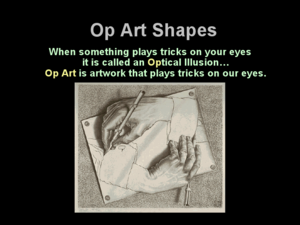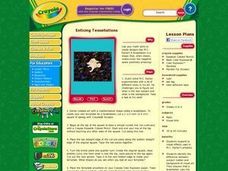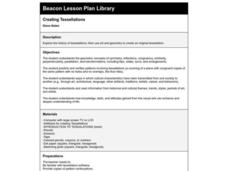Curated OER
Terrific Tessellations
Students create to pieces of artwork using two primary colors and tessellation techniques. This is an excellent lesson that can be accomplished using standard art techniques or educational software such as Adobe Photoshop or Microsoft...
Curated OER
Op Art Shapes
Op art is fun to look at, and it's fun to make. Kids learn about the origins of op art and the op art master, M.C. Escher. They view simple to complex examples of op art to see how it works and then create an optical piece of their own....
Curated OER
Enticing Tessellations
Students respond to visual effects used in M.C. Escher's artworks. They identify the difference between subject matter and background of visual art. They compare and contrast the basic shapes to create a tessellation with the more...
Curated OER
Tessellations: Geometric Patterns
Students create tessellation drawings using repeating geometric shapes.
Curated OER
Terrific Tessellations
Students construct tesselations that fosters their ability to create, transform, and critique their own piece of work. This allows them to become aware of repeated patterns in math, and connect these patterns to artwork.
National Gallery of Canada
Tantalizing Tessellations!
Examine repeating and intricate patterns with a study of M.C. Escher and a related art activity. Pupils view and discuss the artwork before creating their own tessellating patterns. Step-by-step instructions for creating a template are...
National Gallery of Canada
Lumps, Bumps, Gritty, and Soft!
Texture can really add to a work of art. Explore texture through observation and practice. Learners view and discuss works of art by M.C. Escher. They then create their own texture samplers with six different materials.
Curated OER
Tessellation Design And Construction
Students study the basic elements and concepts of the visual art's perceptual component - such as shape, line and color. They create tessellations that foster problem solving and reflective thinking.
Curated OER
What do two-dimensional tessellations look like? Where in art can they be found?
Students explore the world of art and culture, including the works of M.C. Escher. They identify and create original tessellations. Students use a wealth of interactive multimedia applications. They explore the artistic representations...
Curated OER
Midwest Hospitality
Students create snowflakes using the ideas of symmetry, perpendicularity, and regularity in this Art lesson that incorporates Mathematical concepts and artistic design. The lesson includes a materials list, vocabulary list, and possible...
Incredible Art Department
Notan Collages - "Expanding the Square"
Notan is a Japanese word that expresses the interaction between light and dark. Learners explore Notan while creating dimensional art pieces that examine positive and negative spaces. They'll discuss the art of Notan, create...
NTTI
Transform Your Geometry into a Work of Art
Mathematicians utilize artwork to help illustrate the major ideas of transformations and tessellations. They visually identify transformations including reflections, rotations, and translations. They discuss how artists have used...
Curated OER
Tesselations
Seventh graders produce a tessellation of an original design developed using an equilateral triangle, where three unique symmetrical faces rotate throughout their creation.
Curated OER
Lines and Patterns
Here are six outstanding art lessons on geometry, line, shape and form, light and shadow, line and pattern, and tessellation for you. Each activity is well-worth implementing with your art students. These lessons would be especially good...
Curated OER
Creating Tessellations
Third graders explore the history of tessellations; then use art and geometry to create an original tessellation.
Curated OER
Visual Arts: Matisse and Escher
Third graders are introduced to the art of Henri Matisse and M.C. Escher. They create original works in the styles of Matisse and Escher and consider how their innovations have affected modern art.
Curated OER
Mathematics in Art?
Fifth graders view prints of M.C. Escher's work. They look at examples of geometric figures and polygons and discuss places they have seen them. Students create their own tessellations. They write a report about the process they used in...
National Gallery of Canada
Self-Portrait, Mirrors and Metamorphosis!
Using M.C. Escher's Hand with Reflecting Sphere as inspiration, learners create their own set of self-portraits using various reflective surfaces. The lesson begins with a discussion about portraiture and ends with a presentation of work...
Curated OER
Tessellations and T-Shirts
Pupils combine the visual arts and technology with mathematics in the creation of these beautiful t-shirts. They view examples of the work of artist M.C. Escher.
Curated OER
Mosaics of Cyprus
Students create digital mosaics. In this visual arts activity, students discover the attributes and history of mosaics in a teacher-led discussion. Students use an educational program to make their own digital mosaics.
Curated OER
Truly Terrific Tessellations
Third graders discover how the use of pattern is evident in dance, math, and visual art. They create a tessellation pattern, as well as a square dance that show an understanding of the principles of design (balance, repetition, rhythm,...
Curated OER
Mosaic Pavement Panel
Young scholars analyze Mosaic art and identify the tessellation process. In this Mosaic art lesson, students read information about Mosaic art and the tessellation process. Young scholars compare mosaics from various civilizations and...
Curated OER
Architecture
Students study tessellations and the work of M.C. Escher. They discuss the terminology of architecture, the historical significance of architecture in different parts of the world, and create their own piece of architecture out of...
Curated OER
Terrific Tessellations
Students create, transform, and critique their own piece of artwork. In doing this lesson, students get more experience working with angles, lines, and measurement. They gain experience seeing, and creating their own patterns and shapes.























